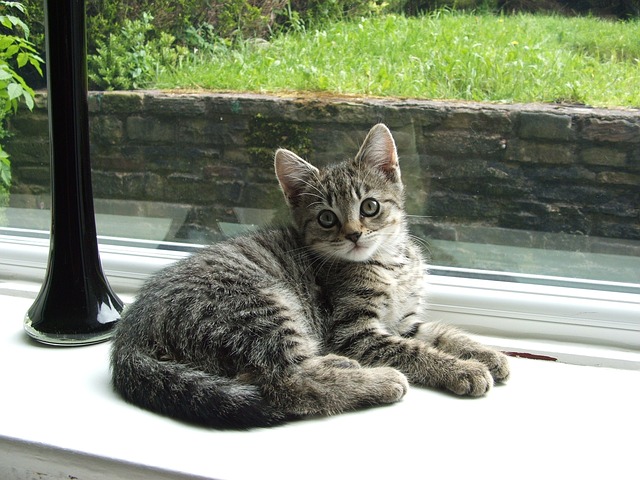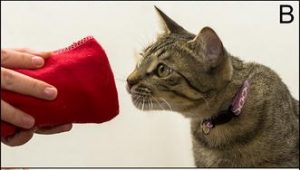No, but we’ve got lots of other things to talk about!
What factors lead some cats to develop behavior problems? And what effect does early experience have on kitten behavioral development? There are still many elusive and unanswered questions, but a new study brings us a little closer to understanding some of the relationships between age of spay/neuter (s/n), household variables (such as number of other pets, use of punishment), kitten personality factors (such as fearfulness) and report of behavior problems by owners.
“Development of behavior in adopted shelter kittens following gonadectomy performed at an early age or at a traditional age” (well that’s a mouthful) by Porters et al. (in press at the Journal of Veterinary Behavior, 2014) examined the relationship between time of s/n (either at 2-3 months or 6-8 months) and report of both short-term and long-term behavior issues. Previous studies have suggested no problems, increased shyness in early-neutered kittens, or increased aggression and less affection in late-neutered cats. Hmm, well that’s a whole lot of mixed messages. The goal of the current study was to address some of the weaknesses of previous studies, which suffered from small sample sizes, lack of long term follow up, lack of random assignment to groups, and reliance on owner recall rather than frequent surveys of current kitten behavior.
The current study started out with a large sample size of 800 shelter kittens in Belgium, which were randomly assigned to either prepubertal gonadectomy (PPG, neutered at age 2-3 mos.; n=533) or traditional age gonadectomy (TAG, neutered at age 6-8 mos; n=267). All kittens were either neutered (PPG) or microchipped (both groups) at 8-12 weeks of age. At this time, kittens were rated as friendly, shy or frightened. More than half of all kittens were adopted into homes with other cats or kittens.
After adoption, owners were surveyed at 2, 6, 12, 18 and 24 months to track behavior issues and other household factors. Unfortunately, there was a pretty huge dropout (which is not uncommon in longitudinal studies), whittling things down to a pittance of 70 surveys at the end.
Surveys inquired about the presence of behaviors, such as negative relationships with other pets, litterbox avoidance, fearful behavior, aggression, solitary behavior, hunting, sexual behavior, activity levels and attention seeking behavior. These behaviors were classified into “potentially undesirable” (owners reported a behavior problem, but said it didn’t bother them) or “undesirable” (owner reported that the behavior problem bothered them).
The survey also asked adopters about their use of punishment, time spent alone by the kitten, how often they cleaned the litterbox, use of enrichment, and the routine in the household.
Given that the main purpose of the study was to determine if time of s/n affected behavior problems, the big reveal is that no, there was no clear statistical impact of PPG/TAG status on any of the behavior variables at any point during follow up. However, some other interesting findings were revealed…
Short-term findings
Upon the first survey (two months after adoption), 470 out of 480 adopters reported some potentially undesirable behaviors, most commonly play-related aggression, fear and destructive behavior. Um, that’s 97.9%!!! Basically, there were 10 well-behaved kittens in the study, and male kittens tended to show more potentially undesirable behaviors than female kittens. However, owners did not seem to feel these behaviors were disturbing, perhaps dismissing them since kittens are so ridiculously cute, it’s just not possible to get upset at their naughtiness.
There were some other variables associated with the presence of these behaviors. First of all, use of physical punishment was related to a greater likelihood of housesoiling (note: we have a chicken and egg problem here, we don’t know if physical punishment leads to an increase in housesoiling, or if housesoiling is a behavior problem that people are sadly more likely to respond to with physical punishment). Verbal and/or physical punishment were both related to the presence of fear, destructive behavior and play aggression. Single cats were also more likely to be fearful and play aggressive, and fear and housesoiling were also related to kittens spending less time with their owners.
Long-term findings

At all other periods of the follow up surveys, anywhere from 89.5 – 98.6% of cats displayed at least one potentially unwanted behavior. As kittens grew into adults, owners were more likely to find those behaviors problematic. Punishment was correlated with more aggression, but less fear. I wonder if this is because owners are less likely to use verbal or physical correction with fearful cats, because they either view them as more sensitive or less willful?
Single cats were still more destructive, and fearful kittens were more likely to be fearful adults and more likely to have problems with housesoilling. People were also more likely to perceive housesoiling as problematic, compared to other behaviors. Interestingly, while too many cats in a territory can cause social stress, which often leads to housesoiling, authors of this study reported that when multi-cat households reported housesoiling, it was related to having less litterboxes than cats.
What did we learn?
So what can we conclude from this study? There is a lot of rich data here to mull over, and obviously more questions for the future.
- First of all, I’m thinking cat owners need a lot more behavioral help than they are getting. If almost all cats are showing potentially problematic behaviors, we either have an awful lot of naughty cats out there in the world and/or a lot of owners who don’t know how to remedy these behaviors. Guess that’s a bit of job security for cat behavior consultants like myself.
- Punishment is correlated with problem behaviors in cats. This has also been demonstrated with dogs (both in the presence of and number of problem behaviors). Again, this doesn’t show causality, but may be dependent on the type of problem (owners were more likely to say that housesoiling is problematic, so perception of severity of the problem may be a factor) or even the personality of the cat (fearful or not). I also feel like I have to say for the record that most behavior experts agree: punishment is not considered an effective means of changing problem behaviors, and is not without its own adverse side effects (see here for an example).
- Growing up as a single cat may make kittens more likely to exhibit problematic behaviors as adults. Adopt a pair!
- Early spay/neuter does not appear to have a negative effect on behavior. While there are some questions about the health effects, this study suggests that early s/n is a good way to prevent unwanted kittens without adverse behavioral impacts.
This study also highlights the difficulties in doing this type of research – the fact that it’s hard to get owners to comply with two years of follow-up – makes it hard to know for sure if 98% of cats are naughty, or if owners with well-behaved cats are less likely to follow up with the researchers! It also suggests that there are many factors that might contribute to problem behaviors in cats…and that there’s plenty of work for us researchers of the human-pet relationship to do!







Interesting! But is 2-3 months really an ‘early’ s/n? From my experience raising orphaned kittens, they are already pretty much set in their ways by 12 weeks. I don’t see how any study could parse out rearing factors if they are coming to the game so late.
I think “early” in this case is defined as pre-puberty. But that is definitely past their sensitive window for socialization (2-7 weeks). I think earlier than eight weeks has some possible risks; until recently 6-8 months was considered the norm.